Related Research Articles
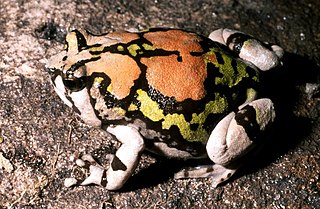
The Scaphiophryninae are a subfamily of microhylid frogs native to Madagascar.
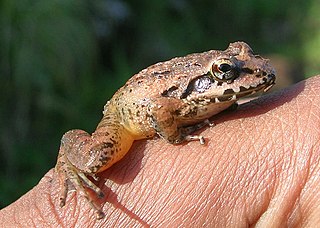
Indirana is a genus of frogs in the family Ranixalidae. These frogs are endemic to the Western Ghats of India. They are sometimes known under the common name Indian frogs, whereas members of their parent family are named "leaping frogs".

Desmognathus is a genus of lungless salamanders in the family Plethodontidae known as dusky salamanders. They range throughout the eastern United States as far west as Texas, and north to southeastern Canada.
Aromobates meridensis is a species of frog in the family Aromobatidae. It is endemic to the Cordillera de Mérida near Chorotal, Venezuela.
Eleutherodactylus interorbitalis, also known as the Sinaloa piping frog and spectacled chirping frog, is a species of frog in the family Eleutherodactylidae. It is endemic to Mexico and is known from the states of Sonora, Chihuahua, Sinaloa, and Durango. It occurs in the foothills of tropical deciduous forest and in open oak woodlands with a rocky, grass understory at elevations of 200–1,600 m (660–5,250 ft) above sea level. It tolerates deforestation as long as there are rocky areas available. Development is direct. It can locally suffer from habitat deterioration but is not threatened overall.

Leptodactylus latrans is a species of frog in the family Leptodactylidae. It is native to much of South America east of the Andes, and Trinidad and Tobago. It has many common names, including rana criolla, sapo-rana llanero, butter frog, and lesser foam frog.
Barygenys cheesmanae is a species of frogs in the family Microhylidae. It is endemic to eastern New Guinea and is only known from Mount Tafa in Central Province, Papua New Guinea. The specific name cheesmanae honors Lucy Evelyn Cheesman, an English entomologist, explorer, curator at London Zoo, and collector of the holotype. Common name Cheesman's Papua frog has been coined for this species.
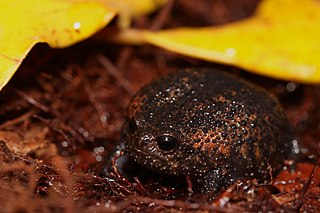
Breviceps acutirostris, also known as common rain frog, strawberry rain frog, or Cape short-headed frog, is a species of frog in the family Brevicipitidae. It is endemic to the southwestern Cape region in South Africa. It is a burrowing frog that lives in fynbos heatland and forests at elevations below 1,600 m (5,200 ft) above sea level. Development is direct . It is threatened by habitat loss, although much of its habitat is also protected.

Choerophryne rostellifer, also known as the Torricelli Mountain frog, is a species of frog in the family Microhylidae. It is endemic to New Guinea and currently only known from Papua New Guinea, with records from the coastal ranges in the north, between the Adelbert Range in the east and the Bewani Mountains in the west, and further southward to the Star Mountains. Some records are from close to the Indonesian border, and it is probable that this species is to be found also in Western New Guinea.
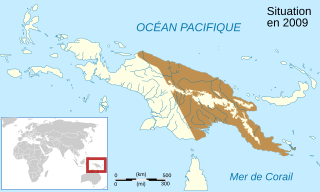
Mantophryne lateralis is a species of frog in the family Microhylidae. It is endemic to New Guinea and is found on the north coast of Papua in Indonesia and both north and south of the Central Range in Papua New Guinea. It is also known from the Normanby Island. Common name Victoria archipelago frog has been proposed for it.
Oreophryne kapisa is a species of frog in the family Microhylidae. It is endemic to the Indonesian islands Biak and Supiori, northwest of New Guinea. Common name Kapisa's cross frog has been proposed for it.

The Petropedetidae are a family of frogs containing two genera and 11 species. They are found in sub-Saharan tropical Africa and are sometimes known under common name African torrent frogs.
Liurana medogensis, commonly known as Medog papilla-tongued frog or Medog eastern frog, is a species of frog in the family Ceratobatrachidae. It is found in Mêdog County, Tibet (China) and in Arunachal Pradesh, northeastern India. However, the records from India might represent another species, and the IUCN SSC Amphibian Specialist Group (2020) does not include them in the range of this species.
Ingerana reticulata is a species of frog in the family Dicroglossidae. As presently known, it is endemic to Mêdog County in southeastern Tibet, China, but its range might extend to northeast India, given the proximity of the border. Common names reticulate eastern frog, reticulate wrinkled ground frog, and reticulated papillae-tongued frog have been coined for it.

Lankanectes corrugatus is a species of frog in the family Nyctibatrachidae. It was once monotypic within the genus Lankanectes, until the second species - Lankanectes pera was described in 2018 from Knuckles Mountain Range. It is endemic to Sri Lanka.
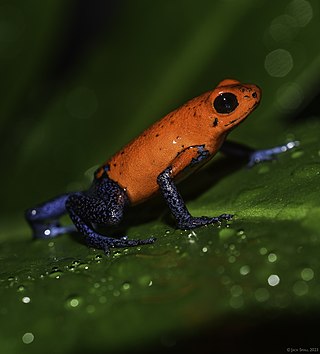
Oophaga is a genus of poison-dart frogs containing twelve species, many of which were formerly placed in the genus Dendrobates. The frogs are distributed in Central and South America, from Nicaragua south through the El Chocó to northern Ecuador. Their habitats vary with some species being arboreal while other being terrestrial, but the common feature is that their tadpoles are obligate egg feeders. Most species in this genus are seriously threatened and O. speciosa is already extinct.

Adelphobates is a small genus of poison dart frogs. They are found in the central and lower Amazon basin of Peru and Brazil, possibly Bolivia. It was originally erected as a sister group to the Dendrobates and Oophaga genera. The validity of the genus is still being discussed, with the alternative being "Dendrobates galactonotus group" within Dendrobates. One species originally placed in this genus as Adelphobates captivus has since been moved to the genus Excidobates erected in 2008.

Nyctibatrachidae is a small family of frogs found in the Western Ghats of India and in Sri Lanka. Their common name is robust frogs. Recognition of Nyctibatrachidae as a family is fairly recent. These frogs were previously placed in the broadly defined family Ranidae, which was more recently divided into three subfamilies: Lankanectinae, Nyctibatrachinae, and Astrobatrachinae.

The Ranoidea are a superfamily of frogs in the order Anura. Members of this superfamily are characterised by having the pectoral girdle fused into a single complex unit, having no ribs, and using an axillary grip during amplexus. The larvae have a single spiracle on the left side and complex mouthparts, or in some species, undergo direct development. The taxonomy of these families has been under heavy debate for many years. In recent studies, molecular data has been used to better identify the phylogentic relationships of these frogs, rearranging and introducing new subfamilies to better distinguish between large groups of frogs.

Gosner stage is a generalized system of describing stages of embryonal and larval development in anurans. The Gosner system includes 46 numbered stages, from fertilized embryo to the completion of metamorphosis. It was introduced by Kenneth Gosner in 1960. The system is widely used in herpetology to describe exotrophic tadpoles. Gosner stages are based on certain morphological landmarks that allow comparing development in different species that may greatly differ in age or size.
References
- ↑ Media, Biology Social. "Janalee P. Caldwell". www.ou.edu. Retrieved 2024-12-29.
- ↑ White, Heidi (2006-06-16). "News Science kits made for girls". The Daily Nebraskan. Retrieved 2024-12-29.
- ↑ "TROPICAL TREE FROG COMMUNITIES: PATTERNS OF REPRODUCTION, SIZE, AND UTILIZATION OF STRUCTURAL HABITAT. – ProQuest". www.proquest.com. Retrieved 2024-12-29.
- ↑ "American Archive of Public Broadcasting Search Results". americanarchive.org. Retrieved 2024-12-29.
- ↑ "NSF Award Search: Award # 9909496 – Wonderwise 4-H". www.nsf.gov. Retrieved 2024-12-29.
- ↑ Vitt, Laurie J.; Caldwell, Janalee P. (2014). Herpetology: an introductory biology of amphibians and reptiles (Fourth ed.). Amsterdam ; Boston: Elsevier, AP, Academic Press is an imprint of Elsevier. ISBN 978-0-12-386919-7. OCLC 839312807.